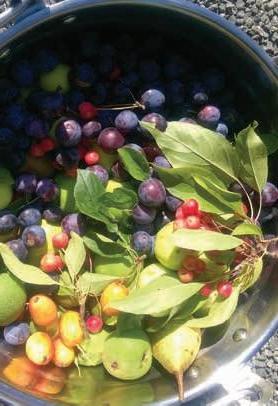
3 minute read
Summer Lovin’
Summer Foraging
It’s the start of the berry season! Adele Nozedar encourages all to sample the berrylicious delights on offer this summer.
Advertisement
Ah, berries…. For many of us, they’re the best part of the wild harvest, and with good reason! Blackberries, for example, are so much a part of our landscape that we sometimes forget what a valuable addition they are to the foraged goodies in our basket. I’d guess that picking those common, delicious and easy-to-find little flavour bombs, for many of us, are the beginning and end of picking the wild stuff - and that’s just fine. And for those of us lucky enough to be in Wales, how about wimberries, or ‘llus’ in Welsh? Part of the summer landscape, for me, is a languid walk in the Brecon Beacons, gathering the glittering black/blue berries which stain lips and teeth purple. Berries, more than any other part of foraging, tell the story of Summer in Wales, gathering not just fruit but the heat of the day, the calls of the birds, the sounds of the water and the delight of the flavours…
What exactly IS a berry?
Good question, but you may wish you hadn’t asked…
A proper, official berry (according to botanists) is a simple fleshy fruit formed from the ovary of one flower, with seeds embedded in the flesh. Typically, berries are juicy, rounded, brightly-coloured, sweet or sour, and don’t have a stone or pit, although many pips or seeds may be present. Blueberries, gooseberries, cranberries, grapes, tomatoes, peppers and even bananas are actually berries. In fact - just to astonish you all a bit more - blackberries, strawberries, and raspberries aren’t actually berries at all! They’re compound drupes! At the end of the day, though, we are allowed to ignore these formalities and eat our fill of lots of lovely fresh free fruits!
I don’t care what they are! When can I pick them?
The season does vary a little from year to year depending on the weather and where you are, but a good rule of thumb is to keep your eyes open for ripening wild fruits any time from July onwards. Also, there are lots of garden plants, which you might think of as purely ornamental, which also yield berries! Mahonia (aka Oregon Grape) will fruit from as early as May onwards, and Himalayan Honeysuckle has berries which taste of a spicy dark chocolate.
Rosehips, too, are easy to overlook, and ripen at different times according to the variety of the rose –and you can eat ALL rose hips. The best ones are the Rosa rugosa ones – they’re very common, growing to be as big, or even bigger, than cherry tomatoes! Find a nice bright red one and squeeze to see if it’s ripe; if there’s no distinct ‘squish’ then move on to another one. Peel away a little of the flesh, and taste. It’s exotic, a cross between oranges and vanilla – really! You’ll always remember the first time you try your first raw rosehip flesh; I’ve had people gasp in surprised delight! Just make sure you don’t eat the furry little pippy bit.
Here’s the easiest-ever rosehip syrup recipe for you. It’s fine to double up the measurements:
• 500g ripe rosehips • 250g caster sugar • Water • Squeeze of lemon juice

Method
Wash the hips thoroughly, pop into a pan, and cover with cold water. Bring to the boil and let simmer for 10 minutes or so until soft, then strain through a finemeshed sieve making sure that you remove those furry little pips, which can irritate your throat.
Add the sugar, bring to a boil, lower the heat and cook gently, stirring from time to time so the liquid doesn’t burn. Reduce the volume by about a third and leave to cool. Once cool add a squeeze of lemon juice. Use as your imagination warrants; drizzle over ice cream or yoghurt…even add to a glass of chilled prosecco. Iechyd da!










